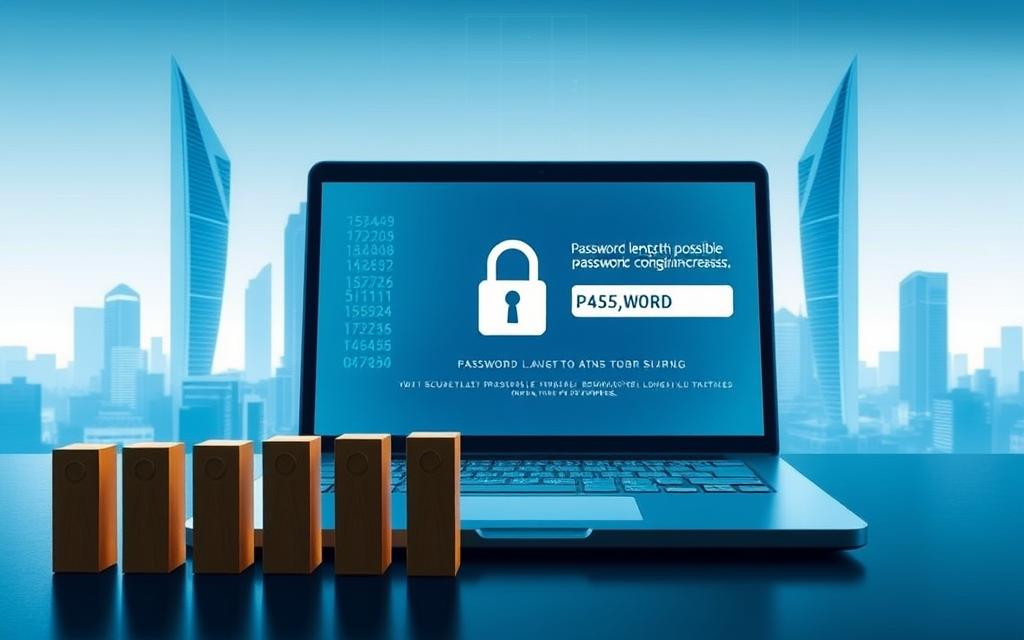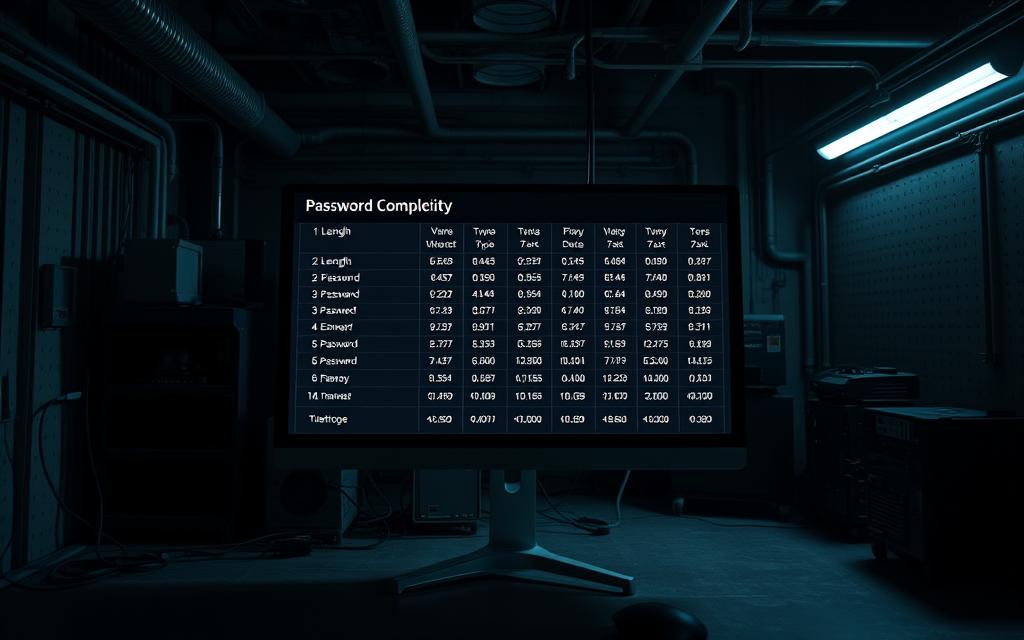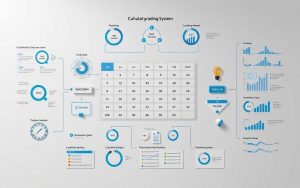Password complexity is key to computer system security. It protects sensitive information from unauthorized access. Math calculations help design strong password systems and determine possible combinations.
Secure passwords use a mix of characters. Most systems require 8 to 12 characters for passwords. This balances user ease and security needs.
The character set includes 68 unique options. These are 26 lowercase letters, 26 uppercase letters, 10 digits, and 6 special characters.
Experts suggest using varied characters for stronger passwords. Understanding the math behind password complexity helps create better authentication strategies. This protects against potential breaches.
The number of possible passwords is about \(1.29 \times 10^{22}\). This huge number makes random passwords hard to crack. It provides strong defense against unauthorized access attempts.
Understanding Password Complexity and Character Sets
Password security hinges on character sets and their role in creating strong digital barriers. Crafting a robust password requires careful character selection to maximize complexity and minimize vulnerability.
Effective passwords use multiple character types to boost security. The main character sets include:
- 26 lowercase letters
- 26 uppercase letters
- 10 numerical digits
- 6 special characters
Types of Available Characters
Character sets are crucial for password strength. Combining different types can greatly increase a password’s resistance to hacking. Case sensitivity adds complexity by doubling potential character combinations.
“Password complexity is not just about length, but about strategic character diversity.” – Cybersecurity Expert
Role of Case Sensitivity in Passwords
Case sensitivity turns password creation into a sophisticated security strategy. It distinguishes between uppercase and lowercase letters, creating 52 character options instead of 26. This greatly expands possible password combinations.
Special Characters and Their Impact
Special characters are key defenders against brute-force attacks. Using symbols like @, #, $, %, ^, and & greatly increases password complexity. 89% of web application breaches come from stolen or guessed passwords.
Using various character sets can create over 159,238,157,238,528 unique password possibilities. This provides strong protection against unauthorized system entry.
Password Length Requirements and Their Significance

Secure passwords require careful thought about length. Minimum password rules are key for strong digital defense. Experts suggest 8 to 12 characters for maximum protection.
Password length matters when looking at math possibilities. Longer passwords create more combinations, making them harder to crack.
- 8-character passwords generate approximately 6.01 × 10^14 possible combinations
- 12-character passwords dramatically increase complexity to 1.27 × 10^22 potential variations
- Each additional character exponentially enhances security
Password length affects how long it takes hackers to break in. A 12-character password could take 409,524 years to crack using brute-force methods.
Minimum password rules help set basic security standards. By requiring certain lengths and complexity, companies can reduce unauthorized access risks.
“The longer the password, the harder it is to crack” – Cybersecurity Principle
When making passwords, focus on length and character variety. Use uppercase, lowercase, numbers, and special characters.
Avoid predictable patterns in your passwords. This approach creates a strong digital shield against potential threats.
How Many Different Passwords Are Available for This Computer System
Password combinations are key to digital security. Knowing how to calculate potential passwords helps create strong protection strategies. Experts study password complexity to improve system defenses.
The password calculation formula relies on character types and length limits. Math shows that more character options greatly increase password possibilities.
Basic Password Calculation Formula
To find total password combinations, math experts use a simple method:
- Count available character types
- Calculate possible characters per position
- Multiply potential combinations across password length
Total Possible Combinations
The calculation adds up exponential combinations for different password lengths. For our system, we use 68^8 + 68^9 + 68^10 + 68^11 + 68^12.
| Password Length | Character Set | Possible Combinations |
|---|---|---|
| 8 characters | 68 possible characters | 68^8 |
| 9 characters | 68 possible characters | 68^9 |
| 10 characters | 68 possible characters | 68^10 |
| 11 characters | 68 possible characters | 68^11 |
| 12 characters | 68 possible characters | 68^12 |
Impact of Character Restrictions
Character limits greatly affect password combinations. Limiting available characters reduces total possible passwords, making systems more open to attacks.
Security experts suggest using many different characters to make passwords stronger. This helps protect systems from potential breaches.
Time Required to Crack Different Password Combinations
Password cracking is a major security risk for computer systems. Hackers use brute force attacks to break passwords by testing many combinations. The cracking time varies based on password complexity and length.
The math behind password cracking is fascinating. With 68 possible characters and fast processing, cracking all passwords takes an incredibly long time.
- Total possible password combinations: 1.29 × 10^22
- Time to check each password: 1 nanosecond
- Total estimated cracking time: 409,524 years
Brute force attacks get harder as passwords get longer. Let’s look at how combinations increase with length:
| Password Length | Total Possible Passwords |
|---|---|
| 8 characters | 6.01 × 10^14 |
| 9 characters | 4.09 × 10^16 |
| 10 characters | 2.78 × 10^18 |
| 11 characters | 1.88 × 10^20 |
| 12 characters | 1.27 × 10^22 |
This growth shows why longer passwords are so important. Using diverse characters also boosts security against cracking attempts.
Password Security Enhancement Through Character Variety
Strong passwords need smart character choices. Mixing different types of characters boosts password strength. This helps protect your digital accounts from unauthorized access.
Experts stress the importance of using various characters in passwords. This approach greatly reduces the risk of hacking. It makes passwords much harder to guess or crack.
Importance of Mixed Character Types
Using different character types offers big security benefits. It makes passwords more complex and less predictable. This approach also increases the number of possible password combinations.
- Increases password complexity exponentially
- Reduces predictability for potential hackers
- Expands total possible password combinations
Passwords with special characters have 9.49 × 10^21 possible combinations. This makes them far more secure than simple alphanumeric passwords.
Strategic Password Construction
To create strong passwords, be intentional about character selection. Use a mix of uppercase and lowercase letters. Add numbers and special characters too.
- Use lowercase and uppercase letters
- Include numeric digits
- Integrate special characters
- Avoid predictable character patterns
“Complexity is the enemy of security, but thoughtful complexity is its guardian.” – Cybersecurity Principle
Common Security Vulnerabilities
Many users make password mistakes that weaken security. These include using sequential characters or repeating character types. Short passwords and avoiding special characters are also risky.
- Using sequential characters
- Repeating character types
- Selecting short password lengths
- Avoiding special character integration
By using mixed character types, you can create strong passwords. This approach makes it much harder for hackers to access your accounts.
Mathematical Analysis of Password Strength
Password strength analysis uses complex math to evaluate security. It calculates the total possible password combinations based on specific parameters. This method relies on combinatorics principles.
Researchers use combinatorics to measure password complexity with precise formulas. Here are some key insights to consider:
- Total possible characters: 68 (including lowercase, uppercase, digits, and special characters)
- Password length ranges from 8 to 12 characters
- Total possible passwords: \(1.29 \times 10^{22}\)
Let’s break down password potential across different lengths:
| Password Length | Possible Combinations |
|---|---|
| 8 characters | \(6.01 \times 10^{14}\) |
| 9 characters | \(4.09 \times 10^{16}\) |
| 10 characters | \(2.78 \times 10^{18}\) |
| 11 characters | \(1.88 \times 10^{20}\) |
| 12 characters | \(1.27 \times 10^{22}\) |
Passwords with special characters offer better security. About approximately 9.49 × 10^{21} passwords have at least one special character. This greatly increases complexity and resistance to breaches.
A thorough password strength analysis isn’t just about counting characters. It needs advanced combinatorics techniques to assess security accurately. This approach gives a deeper understanding of password security.
Conclusion
Digital security insights reveal mind-boggling numbers in password complexity. With over 1.29 × 10^22 possible combinations, users can create strong digital barriers. Strategic character selection can greatly increase protection against cyber threats.
Understanding password math helps people make better access credentials. Using various character types can significantly reduce vulnerability. Hackers would need about 409,524 years to try all possible combinations.
Password security is crucial in our digital world. Users should create complex, long, and unpredictable passwords. The goal is to balance easy-to-remember with hard-to-guess passwords.
Digital security is always changing. Passwords are the first defense against unauthorized access. By using these principles, people can improve their password creation methods. This turns complex math into a strong shield for digital assets.




